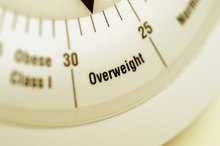When to Expect Weight Loss Results From Rebounding
Jumping up and down on a mini trampoline seems more like fun than a workout, but it can help you burn calories and improve circulation. Like any cardiovascular exercise, rebounding -- the name for a mini trampoline workout -- can help you lose weight. When you’ll see those pounds drop off really depends on how aggressive you are with other aspects of your weight loss plan -- particularly your eating plan.
Calorie Burn
Rebounding burns approximately 160 calories per 30-minute session for a 150-pound person. To lose weight, you need your daily calorie burn to exceed your calorie intake from food and beverages. If all you are doing is adding a half-hour rebounding session and not changing your diet, you will lose approximately 1 pound every three weeks – and that is assuming your calorie intake prior to adding rebounding matched your daily calorie burn. For most people, a 1-pound loss isn’t very noticeable, so it may take several months – once you lose 10 pounds or more – for your results to show up.
Eating
How To Lose Weight with Dumbbells
Learn More
Among members of the National Weight Control Registry, a group of more than 10,000 people who have lost an average of 66 pounds and kept it off for more than five years, 89 percent used a combination of diet and exercise to achieve success. Trimming your daily calorie intake along with regular rebounding sessions will accelerate your weight loss results. If you currently consume 2,000 calories per day to maintain your weight, trim it to 1,500 and you can stimulate a pound of weight loss per week since one pound equals 3,500 calories. You should aim to fill up the calories you do eat with nutritious options such as leafy greens, whole grains and lean proteins rather than sugary sweets, refined flours and saturated or trans fats. To figure out your daily calorie burn, consult an online calculator. You can lose this additional pound in addition to the 1/3-pound weight loss you’ll see from daily 30-minute rebounding sessions.
Frequency and Intensity
If your only exercise consists of rebounding a few times per week, you may not notice any weight-loss results. The American College of Sports Medicine says you need at least between 250 and 300 minutes of moderate-intensity cardio exercise weekly to experience significant changes in your weight. That equals 50 minutes, five times per week, on your mini-tramp. You also have to be sure you get your heart beating faster and your breath coming heavier during your session for it to count as moderate intensity. In addition to cardio exercise from rebounding, fit in two total-body resistance training sessions weekly that target the major muscle groups with one set of eight to 12 exercises. Use weights that fatigue you by the end of your repetitions.
Additional Benefits
Ashtanga Yoga & Weight Loss
Learn More
You may have added rebounding to your routine to lose weight, but know you are providing your body with numerous additional benefits. Rebounding enhances your balance and coordination. It also stimulates your lymphatic system which plays a role in immunity and circulation. Rebounding also counts as a weight-bearing exercise, improving bone density.
Related Articles
References
- Time: We Tried This: The Urban Rebounding Workout
- CBS News: Exercise on the Rebound
- Jump Sport Trampolines: What is Rebounding?
- Self: Health Calculators
- American Council on Exercise: Diet Versus Exercise
- The National Weight Control Registry: Research Findings
- American College of Sports Medicine: ACSM Position Stand on Physical Activity and Weight Loss Now Available
Resources
Writer Bio
Andrea Cespedes is a professionally trained chef who has focused studies in nutrition. With more than 20 years of experience in the fitness industry, she coaches cycling and running and teaches Pilates and yoga. She is an American Council on Exercise-certified personal trainer, RYT-200 and has degrees from Princeton and Columbia University.









